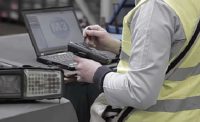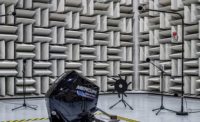Q&A with Dr. Rolf Pfeiffer andDagmar Dübbelde
Dr. Rolf Pfeiffer is the managing director of DEPRAG, and Dagmar Dübbelde is the air motors product manager. For more information, visit www.depragusa.com
What happens when the power from your drive unit simply isn’t enough? When the motor for your robot-controlled plant has to supply maximum power yet has to be physically very small? When it has to produce very high revolution speeds, yet be fit for continuous operation? The automatic processes used to manufacture today’s modern materials place heavy demands on the equipment that drives them. Plant engineers often anguish over the choice of motor to carry out the job. Technical journalist Trixy Schmidt talked to two prominent plant engineers to find out more. During the interview Dr. Rolf Pfeiffer and Dagmar Dübbelde provided an intriguing answer: in applications which require a pneumatically driven turbine with excellent power-weight ratio the ideal solution to the problem is motor selection.
Schmidt:If I am a plant engineer in search of the ideal motor for my application I basically have to decide whether the drive for my motor should be pneumatic or electric. What are the advantages of compressed air as an operating fluid?
Dr. Pfeiffer:Ever since the days of mining and tunneling operations in the 19th century air tools have represented a great success story. In atmospheres at risk of firedamp where a single spark could cause an explosion it would have been unthinkable to use an electric motor. The same is true today. Wherever there is a risk of explosion—for example in the bulk materials handling systems as used in the chemicals industry—the air motor will come into its own. The other side of the coin is that air motors can also be sterilized and are therefore used within the medical technology industry.
Dübbelde: Furthermore, due to their simple structure air motors and pneumatic tools are immune to dirt and humidity and can be operated under full load down to standstill without damage. However the most significant advantage is that for the required drive output they are a third to a fifth lighter and are more compact than their electric counterparts. Air motors can also be found carrying out automated tasks, for example fastening screws.
Schmidt:It is most often a vane motor that forms the basis of an air drive. Critics of the vane motor point out that it makes inefficient use of the volume expansion properties of the compressed air, so uses more electric energy than an electric motor.
Dübbelde:To counter that suggestion properly, we need to dig more deeply. You cannot make a direct comparison between air motors and electric motors. Ultimately it is the application that is the deciding factor in the choice of drive. For example: take a look at the torque graph for an air motor compared with an electric motor in a packaging machine. For this application the required speed is approximately 450 rpm. However, for an extended period the torque is at 25 Nm at a reduced speed in order to seal the packing tape. Electric motors cannot withstand overload for extended periods because they overheat. So for this application an electric motor would need to be designed for torque under load, requiring an output of 1170 W (25 Nm x 450 rpm, divided by 9,550).
However, the calculations for an air motor are completely different. With the air motor’s superior torque graph and the way it deals with increased temperature, the smaller motor solves both problems. The final choice for this application fell to an air motor with a nominal torque of 15 Nm and a nominal speed of 275 rpm. Since the working torque is below the nominal torque, at low load the motor revolves at close to the no-load speed of 450 rpm. The output required from the air motor is therefore 430W. If all is needed is a mere third of the power of an electric motor, the air motor’s efficiency appears in a completely different light.
Dr. Pfeiffer:In addition to the frequently used vane motor there are also other drive types that use compressed air more efficiently. This is where our turbine technology steps in: A turbine is a fluid dynamic machine which uses the volume expansion properties of compressed air much more efficiently than vane motors do. They use a third of the amount of compressed air. The power-weight ratio (kilowatts/kilograms) is unrivalled, just half the size of the vane motor. An example: if we replace a vane motor the size of a man’s fist with a turbine drive of the same size, we can almost double the amount of power produced.
Schmidt: So pneumatic turbine drives score points for energy efficiency and an outstandingly low power-weight ratio.
Dr. Pfeiffer:Indeed they do. But other features also come into play here. We have already talked about their small size. It means that turbines are particularly suited for robot-controlled applications or where space is at a premium, for example inside the fuselage of an aircraft, but they are also used in high quality manual machinery. We market a turbine grinder which is able to exert as much as 2.2 kilowatts of power onto the grinding wheel, yet it weighs only 1.8 kilograms. A comparable device to deburr, polish or cut using a vane motor and weighing the same would produce only 1 kilowatt of power. Compared with an electrically driven tool the advantage derived from this low power-weight ratio is even more pronounced: To produce the same power an electro-grinder would weigh 5.7 kilograms.
Dübbelde: At this point we should again highlight the turbine drive’s low air consumption figures. On average it uses a third less compressed air than a vane motor. With a centrifugal governor to govern the speed of the turbine motor, air consumption can be reduced further by 50%. No other air motor works as efficiently. The turbines do not need oil, and there are no wear parts. And let us not forget the low noise level. This is another point in favor of using a turbine.
Schmidt: Turbines “live” off high speeds, so they have a reputation for high speed—a term explained by the way these fluid dynamics machines function. Their operating principle ensures that they are ideal for continuous operation. Which applications benefit most from these properties? In which industrial sectors are they of most use?
Dr. Pfeiffer: Primarily they are ideal for stationary applications: grinding, milling, deburring or drilling metals, as well as wood. In short we recommend using a turbine-type drive wherever a constantly high motor speed is required to produce excellent machining quality. Turbines can also be deployed in manual tools where maximum power is required from a lightweight tool.
Dübbelde:And of course they are also ideal for use where there is very little mounting space available. I’m thinking here of drill feed units, where with a turbine I can achieve much greater power from the same size of motor.
Schmidt: The design of a turbine drive involves more complicated configurations than occurs in a vane motor. The geometry of the blade, for example. Does it actually make economic sense to buy a turbine drive?
Dr. Pfeiffer: The engineering design work involved in producing a turbine is much greater than the actual manufacturing process. But if you look closely you find that at our company we have already made many turbine drives. We are able to produce turbine drives in a power range of between 500 W to 50,000 W.
Dübbelde:And because we have also designed and developed the innovative turbine grinder in our Green Energy range, where we have developed a completely new gas expansion turbine to convert unused process gases into electricity, we already have a lot of software tools that we can use to design turbines to customers’ own requirements







